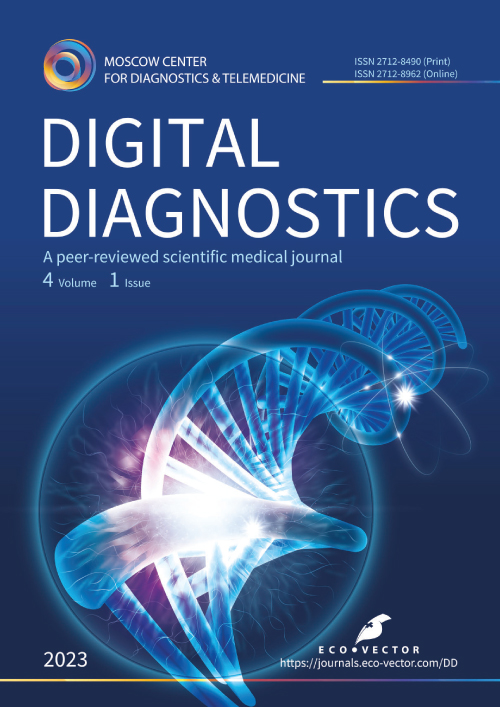腹部病理诊断中的关键脉冲序列
- 作者: Syrkashev E.M.1,2, Kadyrberdieva F.Z.2, Abuladze L.R.1, Semenov D.S.1, Privalova E.G.1
-
隶属关系:
- Moscow Center for Diagnostics and Telemedicine
- National Medical Research Center for Obstetrics, Gynecology and Perinatology
- 期: 卷 4, 编号 1 (2023)
- 页面: 39-50
- 栏目: 科学评论
- ##submission.dateSubmitted##: 18.01.2023
- ##submission.dateAccepted##: 10.03.2023
- ##submission.datePublished##: 19.04.2023
- URL: https://jdigitaldiagnostics.com/DD/article/view/123543
- DOI: https://doi.org/10.17816/DD123543
- ID: 123543
如何引用文章
详细
磁共振成像是诊断腹部和腹膜后器官疾病的主要方法之一,它允许显示出实质器官和空腔脏器的病灶或弥漫性变化,具有很高的诊断准确度和可重复性。与计算机断层扫描相比,磁共振成像在确定实质器官、胆道和胰管、腹膜和腹膜后器官的病理变化的敏感性和特异性方面有明显优势。
多参数扫描方案不仅提供器官的相互形貌及其结构的信息,而且提供组织的功能状态,使图像从结构评估过渡到功能评估。在大多数情况下,标准方案包括腹部扫描(T1-/T2-和扩散加权模式)和胆道扫描(磁共振胆胰管成象),但根据检查的目的和病人的情况,这个方案可以大大缩短或补充。
现有的技术发展和成果允许简化扫描过程和缩短成像时间,同时提高技术在不同医疗机构的方法重复性。
关键词
全文:
绪论
磁共振成像(MRI)是辐射诊断的最重要方法之一,它对腹部疾病的常规诊断的贡献正在稳步增加。除了没有电离辐射和高自然软组织对比度外,磁共振成像允许在任何平面上分析图像,并可对感兴趣的区域进行三维重建。扩散和灌注技术的积极引入不仅提供关于组织结构的信息,而且提供关于其功能状态的信息,包括确定水分子的扩散速度并对比剂的积累和冲刷情况。
磁共振成像是目前主要的诊断方法之一,与计算机断层扫描(CT)相比,在检测实质器官、胆道和胰管、腹膜和腹膜后器官的病理变化的敏感性和特异性方面有明显的优势[1]。
基本脉冲序列
腹部MRI的一个特点是从因病人呼吸、肠道蠕动、心跳和大血管搏动而处于运动状态的组织中很难获得具有高信噪比(signal-to-noise ratio,SNR)的图像。最初,MRI是使用标准自旋回波(spin-echo,SE)序列进行的,伴有获得T1和T2加权图像(weighted image,WI)。然而,漫长的数据采集过程需要额外的与呼吸同步,这也大大增加了扫描时间(在某些情况下,研究协议超过60分钟)[2,3]。在某些情况下,即使是轻微的与呼吸不同步,也会导致图像的解释困难。
目前腹部检查的标准协议包括基于较短序列的技术,是在病人呼吸时进行的。这些技术包括使用扰相梯度回波(spoiled gradient echo,SPGR)的T1WI和半傅立叶单次激发快速自旋回波成像(Half-Fourier Acquisition Single-shot Turbo spin Echo imaging,HASTE或者Single Shot Fast Spin Echo, SSFSE)[4 ,5](表1)。
表1。主要磁共振成像制造商的主要脉冲序列的名称
制造商 脉冲序列 | TOSHIBA | PHILIPS | GE | SIEMENS |
Spin-echo | SE | SE | SE | SE |
Fast spin-echo | FSE | TSE | FSE | TSE |
Single-shot fast spin-echo | FASE | SSh TSE | SSFSE/RARE | HASTE |
Gradient echo | FE | FFE | GRASSE, GRE | FISP, GRE |
T1-FE | CE-FFE T1 | SPGR | FLASH | |
- | CE-FFE T2 | SSFP | PSIF | |
Steady-state fast-field echo | TrueSSFP | Balanced FFE (BFFE) | FIESTA | True FISP |
Fast scan | FFE | TFE | Rapid SPGR | TurboFlash |
Saturation bands | PreSat | REST | SAT | PreSAT |
Fat, eater, and background suppression | FatSat | SPIR | CHEMSAT | FATSAT |
注意。Spin-Echo(自旋回波);Fast Spin-Echo(快速自旋回波);Single Shot Fast Spin-Echo(单次激发快速自旋回波);Gradient Echo(梯度回波);Steady State Fast Field Echo(稳态快速场回波);Fast Scan(快速扫描);Saturation Bands(饱和波段);Fat, water and background Suppression(脂肪、水和背景噪声抑制序列)。
T1和T2加权图像
使用单次激发自旋回波(single shot spin-echo)序列获得单一的T2WI切片需要大约1秒钟的时间,伴有K空间中心填充。因为图像对比度是由K空间中心部分决定的,所以单脉冲技术对病人运动的敏感度明显降低,这对无意识的病人来说是非常重要的。使用梯度回波的T1WI对运动明显更敏感:即使在扫描过程中短暂的运动也会导致对所有切片有影响的图像中的伪影。然而,对运动不那么敏感的技术也是有的,其所依据的原理与单脉冲T2WI的原理相同:通过单脉冲分析单片的快速K空间中心填充(如Turbo fast low-angle shot和FIRM Fast inversion-recovery motion-insensitive)。
另一种方法是使用改良的三维梯度回波序 列(3D gradient echo sequence),这些序列被用于血管造影。取决于制造商,它们有不同的名称(最初是VIBE——Volumetric Interpolated Breath-hold Examination,容积内插屏气检查) [6]。这些序列允许获得高分辨率(约2-3毫米)、几乎各向同性的体素大小的图像,这对肝脏病理及其血管解剖的诊断极为重要。此外,该技术还可用于多平面图像重建。
使用T1WI的另一个重要成分是使用静脉注射对比剂,包括特异性对比剂,如钆塞酸等肝脏特异性对比剂,其特点是对肝细胞有很强的趋同性,可以更好地观察到肝脏肿块(图1)。
图1。 注射肝脏特异性对比剂的肝脏磁共振成像。肝细胞癌结节(箭头):a——T2加权图像:识别出结节性高强化肿块;b——T1加权图像,动脉期:识别出对比剂的环形积聚;c——T1加权图像,注射对比剂后20分钟得到的肝脏特异期。
对比剂缩短T1松弛时间,导致T1WI的信号强度增加。根据局灶性或弥漫性实质器官变化的血供性质,可以从邻近的无变化组织中区分出不同的对比模式。动脉期的成像是通过在使用含钆的对比剂后立即进行短序列实现的。
一项基本方法是使用动态多相二维或三维SGE序列,可用于分析感兴趣区域的信号强度曲线与时间的关系。大多数病理局灶性变变在动脉期的成像效果最好(如脾脏、肝脏或胰腺的局灶性变化)。注射对比剂后1.5-10分钟获得的图像处于造影的平衡阶段,最佳窗口为注射后2-5分钟。一般来说,注射后5分钟说是延迟期或排泄期。许多炎症或肿瘤疾病在这一阶段能更好地显示出来,另外使用脂肪信号抑制有助于更明确地发现这些变化(如腹膜植入物、胆管癌、炎症性肠病和肾上腺体积性肿块)[7-9]。
显然,病理变化与无变化组织的信号强度差异增加,有利于疾病的检测:通过改变T1WI和T2WI上来自脂肪的信号强度,局部脂肪组织的变化相对容易识别。例如,纤维化变化或腹腔液在T1WI时的信号强度较低,在不抑制脂肪组织信号的情况下,更容易在图像上识别。另一方面,具有高信号强度的变化,如亚急性血肿或高蛋白含量的液体,使用脂肪抑制更容易观察到。
扩散加权图像
扩散加权成像(DWI)在不需要注射外源性对比剂的情况下是基于水分子在细胞外和细胞内空间运动(扩散)的差异。这种技术不仅允许对细胞密度进行定量和定性的分析,还允许对细胞膜的完整性进行分析,因此它是一种功能性图像评估的形式[10],所以应该被纳入标准的腹部和腹膜后扫描协议中(图2,3)。
图2。腹部器官的磁共振成像,皮质单纯性肾囊肿(箭头):a——扩散加权图像;b——测量的扩散系数图。虚假的扩散限制。
图3。腹部器官的磁共振成像,肝脏的继发病灶(箭头):a——扩散加权图像;b——测量的扩散系数图。真正的扩散限制。
最初,DWI最常用于脑部病变的诊断,主要是中风:这种脉冲序列的信号变化使缺血性改变在T2WI上变得明显之前就被诊断出来。目前,多亏高振幅梯度、多通道表面线圈和平行成像的发展,DWI可用于诊断各种颅外病变[11]。
扩散与细胞密度和细胞膜的完整性成正比:在细胞性质增多或细胞外液量减少的组织中(如一些肿瘤、脓肿;图4)并在存在细胞毒性水肿的情况下,扩散有限。在细胞密度低或细胞膜受损的组织中,例如在囊肿或坏死的组织中,可观察到相对自由的扩散[12,13]。
图4。腹部器官的磁共振成像,包裹的体积性的肝脏肿块——脓肿(箭头):a——T2加权图像;b——测量的扩散系数;c——测量的扩散系数图。
通过改变梯度的振幅、持续时间和成对梯度之间的时间间隔,可以改变DWI对水分子运动的敏感度。与上述标准成正比的b因子被用于此目的。运动程度高或扩散距离大的水分子(例如在血管内空间)在b因子值较低时显示信号衰减(例如b=50-100 mm2/s)。相反,高的b因子值(如b=1000 mm2/s)通常用来表现缓慢移动的水分子或小的扩散距离,因为它们表现出较慢的信号衰减(随着b因子值增加)。为了正确解释,DVI应该是至少使用两个b因子进行的:b=0 mm2/s和b=100-1000 mm2/s,因为使用b因子=0 mm2/s得到的DVI是T2加权序列。在b值较低时( 如200 mm2/s或更低),测得的扩散系数取决于组织灌注和水扩散,随着b因子的增加,灌注效应降低。一般来说,b因子越高,序列对扩散效应越敏感;此外,高b因子 值( 如100-1000 mm2/s)对背景信号的抑制更合 适[10 ,14]。
常规扫描协议
在大多数情况下,腹部器官的扫描方案包括T2WI、对比前和对比后的T1WI,其中包括脂肪抑制、DWI和磁共振胆胰管成像(MRCP)。这些序列不仅允许看到实质和空心器官壁、胆管的变化,而且允许看到腹膜、腹膜后器官和细胞空间的变化,而且准确性相当高(表2)。然而,根据临床情况、检查的目的和任务,这个方案可以被补充或缩写。根据美国放射学会(American College of Radiology,ACR)建议,切片厚度不应超过8毫米,间距不应超过2毫米,更薄的切片是首选[15]。
表2。基本脉冲序列及其在诊断腹部和腹膜后病变中的重要性
脉冲列车 | 主要的重要性 |
T1 FS | 被用来识别主要由脂肪或包括脂肪组织或出血成分组成的变化(如血管肌脂瘤、畸胎瘤、脂肪性胰腺萎缩症、肾脏皮髓质分界)。作为腹部器官检查中的一个观察列车,用来注射对比剂。 |
T1 in-phase, out-of-phase | 当在同一体素中观察到脂肪和水质子的组合时,被用来显示改变的组织(脂肪肝、肾上腺腺瘤、血色病、含铁血黄素沉着症)。提供与液体或纤维组织含量异常升高有关的信息(亚急性出血、脂肪或高蛋白含量)。 |
T2, Т2 FS | 被用来显示浆液增多、血管瘤、胆管错构瘤、组织水肿、有出血性或高蛋白含量的囊肿、纤维性改变。与out-of-phase T1结合,可用于铁的检测。作为腹部器官检查中的一个观察列车 |
DWI | 原发性和继发性腹腔和腹膜后肿瘤,包括那些在T1或T2上看不到的肿瘤(如腹膜播散)。 |
MRCP | 胰胆系统的评估(狭窄、肝内胆管的囊性改变、胆总管结石、胰腺的囊性改变)。 |
标准的T2WI是使用自旋回波在正面和轴状面进行的。这些序列的数据采集时间相对较长,但允许获得高信噪比。在病人呼吸、大血管搏动和肠道蠕动的背景下,这种方法在腹部放射学中的常规应用是有限的。在这种情况下,可以与呼吸同步,这增加扫描时间(长达5-7分钟),而运动校正不是绝对的:在大多数情况下,在器官边界有模糊效应,这有可能使各种病变的诊断变得更复杂。由于这个原因,目前T2WI更常是使用Accelerated fast spin-echo、Single-shot accelerated fast spin-echo或Steady-state free precession序列获得的(图5)。
图5。SSFSE模式:肝细胞癌伴有下腔静脉侵袭(黄色箭头)、紧张腹水(绿色箭头):a——冠状面投影;b——轴状面。
可以在病人屏住呼吸或不屏住呼吸的情况下获取图像。当使用不屏住呼吸的方法时,应该尽力减少呼吸运动的伪影,使用大量的信号平均和/或呼吸补偿/呼吸触发。与标准自旋回波相比,主要区别是组织对比度的相对降低,这有可能导致诊断错误,特别是针对未改变的实质组织的小变化(如小肝细胞癌)。然而,这一缺点被T1WI所弥补:这些区域相对于未改变的组织通常有较长的T1时间,在原生SGE序列或早期(动脉)对比后图像上可以很好地看到这些作为信号降低的病灶变化的区域。
MRCP是基于一个改良的自旋回波序列的,TE时间为250-500毫秒,获取重T2加权图像(heavily T2-weighted images)。延长TE导致软组织的 “变暗”,而存在于胆管和胰管中的液体被用作“原生”对比剂。
由于腹部充满液体的结构具有较长的T2松弛时间,因此在周围软组织的衬托下,它们会出现高强度的。MRCP应该是在对比剂进入胆管之前进行的(当使用肝脏特异性对比剂时),因为钆会缩短T2时间,导致胆道系统的成像差,所以要在注射对比剂前或使用后5分钟内进行MRCP(例如为了节省时间,甚至可以在注射对比剂后5分钟或更长时间内进行DWI)。此外,还可以进行多平面重 建(multiplanar reconstruction,MPR)和最大密度投影(maximum intensity projection,MIP)以获得最佳成像。
T1WI是使用自旋回波序列(turbo spin-echo [TSE]或fast spin-echo [FSE])进行的,但通常首选梯度回波技术(SGE),因为它的采集数据时间更短。
为了更明确地评估肝脂肪变性或血色素沉着症的征候,标准扫描方案还应该包括T1WI相位和反相位进行的T1WI扫描。此外,该序列在诊断肾上腺腺瘤(图6)、透明细胞肾癌或胰腺脂肪浸润(图7)时提供同样有价值的信息。显然,这些序列必须是在注射对比剂之前获得的。相外图像允许评估来自脂肪组织和含脂肪的肿块(如肝腺瘤或肝细胞癌)的信号损失。同时,肝脂肪变性的无创定量评估的金标准是质子密度脂肪分 数(proton density fat fraction,PDFF)序列。然而,这个序列并没有在常规协议中使用。
图6。腹部器官的计算机断层扫描,轴状面(a):确定了右肾上腺的肿块密度不均匀(箭头);腹部器官的磁共振成像(b,c),相位(b;in phase),反相位(c;opposed phase):确定了反相位中腺瘤脂肪成分的特征信号丧失(箭头)。
图7。腹部器官的磁共振成像,胰腺脂肪瘤(箭头):a——相位(in phase),b——反相位(opposed phase) 。反相位显示了,胰腺信号下降,而肝脏信号正常。
动态对比前和对比后的T1WI是使用二维或三维脉冲序列获得的[6],同时三维序列是首选,因为尽量减少切片厚度允许减少截断伪影。最初,三维SGE序列被用来观察血管解剖(磁共振血管成像;图8)。现在该技术广泛用于腹部和骨盆的软组织结构成像。短的TR和TE值允许在一次屏住呼吸中获得大量的薄片。该序列的潜在局限性是信噪比较低,但这一缺点可通过使用静脉注射对比剂得到补偿。
图8。腹主动脉及其分支的对比增强磁共振成像。风湿主干被膈肌干压迫(箭头):a——SSFE;b——三维模式下的对比增强。
在非接触性患者中,SGE可以是在不屏住呼吸的情况下进行的:这样的序列包括MP-RAGE(magnetization prepared rapid acquisition gradient)和Turbo FLASH(turbo-fast low angle shot)。这种方法的局限性是T1加权组织对比度较低(与标准SGE相比)。另一个缺点是不能用这种技术进行肝脏动态对比度,尤其是在早期动脉期:采集一个切片需要1.5秒,所以扫描肝脏上下两部分的时间差不允许在一 个(动脉)阶段采集所有部分。相比之下,标准的SGE序列虽然对运动敏感,但具有较高的时间分辨率,可以显示所需的组织体积。
DWI在腹部放射学中被广泛使用。屏住呼吸或不屏住呼吸的SS-EPI序列(single-shot echo-planar)是最常用的。平行数据采集被用来减少扫描时间和更明确地计算所测量的扩散系数,现代技术允许在不到1分钟的扫描时间内实现具有高空间分辨率的同步多层成像(simultaneous multislice imaging,SMS DWI)[16](图9)。
图9。在自由呼吸(FB)和呼吸触发(RT)上使用不同的b因子(50,400,800 mm2/s)的标准(STD DWI)和同步(SMS DWI)多层扩散加权图像的比较以及相应的测量扩散系数(ADC)。使用标准扩散加权图像的平均扫描时间为10:30分钟(5:56-18:13),使用SMS-DWI的平均扫描时间为3:29分钟(2:19-4:27)[16]。
结论
磁共振成像是诊断腹部和腹膜后器官疾病的主要方法之一,它允许观察实质器官和空腔脏器的局灶性或弥漫性变化,具有很高的诊断准确和可重复性。多参数扫描方案不仅能提供器官的相互形貌及其结构的信息,而且提供组织功能状态的信息,使图像从结构评估过渡到功能评估。
在大多数情况下,腹部器官的标准扫描方案包括T1WI、T2WI、DWI、MRCP,不过根据检查的目的和病人的情况,这个方案可以缩短或补充。
现在有大量不同的脉冲序列,现有的技术开发和成就允许简化扫描过程并减少成像时间,同时提高各种保健机关中技术的可重复性,甚至在经验不足的用户中也是如此。
ADDITIONAL INFORMATION
Funding source. This article was not supported by any external sources of funding.
Competing interests. The authors declare that they have no competing interests.
Authors’ contribution. All authors made a substantial contribution to the conception of the work, acquisition, analysis, interpretation of data for the work, drafting and revising the work, final approval of the version to be published and agree to be accountable for all aspects of the work.
作者简介
Egor M. Syrkashev
Moscow Center for Diagnostics and Telemedicine; National Medical Research Center for Obstetrics, Gynecology and Perinatology
编辑信件的主要联系方式.
Email: egorsrkshv@mail.ru
ORCID iD: 0000-0003-4043-907X
SPIN 代码: 1901-5364
MD, Cand Sci (Med.)
俄罗斯联邦, Moscow; MoscowFaina Z. Kadyrberdieva
National Medical Research Center for Obstetrics, Gynecology and Perinatology
Email: k.faina1992@mail.ru
ORCID iD: 0009-0004-7787-3413
MD, Cand Sci (Med.)
俄罗斯联邦, MoscowLiya R. Abuladze
Moscow Center for Diagnostics and Telemedicine
Email: AbuladzeLR@zdrav.mos.ru
ORCID iD: 0000-0001-6745-1672
SPIN 代码: 8640-9989
MD
俄罗斯联邦, MoscowDmitriy S. Semenov
Moscow Center for Diagnostics and Telemedicine
Email: semenovds4@zdrav.mos.ru
ORCID iD: 0000-0002-4293-2514
SPIN 代码: 2278-7290
俄罗斯联邦, Moscow
Ekaterina G. Privalova
Moscow Center for Diagnostics and Telemedicine
Email: e-privalova@mail.ru
ORCID iD: 0000-0002-9851-9390
SPIN 代码: 6546-5135
MD, Dr.Sci. (Med.)
俄罗斯联邦, Moscow参考
- Hussain SM, Sorrell MF. Liver MRI: Correlation with other imaging modalities and histopathology, second edition. Springer; 2015. doi: 10.1007/978-3-319-06004-0
- Runge VM, Clanton JA, Partain CL, James AE. Respiratory gating in magnetic resonance imaging at 0.5 Tesla. Radiology. 1984;151(2):521–523. doi: 10.1148/radiology.151.2.6709928
- Bailes DR, Gilderdale DJ, Bydder GM, et al. Respiratory ordered phase encoding (ROPE): A method for reducing respiratory motion artefacts in MR imaging. J Comput Assist Tomogr. 1985;9(4):835–838.
- American College of Radiology [online]. ACR-SAR-SPR practice parameter for the performance of magnetic resonance (MR) Enterography. Available from: https://www.acr.org/-/media/ACR/Files/Practice-Parameters/MR-Enterog.pdf. Accessed: 17.01.2023.
- Semelka RC, Kelekis NL, Thomasson D, et al. HASTE MR imaging: Description of technique and preliminary results in the abdomen. J Mag Reson Imaging. 1996;6(4):698–699. doi: 10.1002/jmri.1880060420
- Rofsky NM, Lee VS, Laub G, et al. Abdominal MR imaging with a volumetric interpolated breath-hold examination. Radiology. 1999;212(3):876–884. doi: 10.1148/radiology.212.3.r99se34876
- Syrkashev EM, Solopova A, Kulabukhova EA. Magnetic resonance imaging in the diagnosis of peritoneal carcinomatosis indisseminated ovarian cancer. Obstetrics Gynecology. 2020;(9):38–47. doi: 10.18565/aig.2020.9.38-47
- Vanderveen KA, Hussain HK. Magnetic resonance imaging of cholangiocarcinoma. Cancer Imaging. 2004;4(2):104–115. doi: 10.1102/1470-7330.2004.0018
- Kilcoyne A, Kaplan JL, Gee MS. Inflammatory bowel disease imaging: Current practice and future directions. World J Gastroenterol. 2016;22(3):917–932. doi: 10.3748/wjg.v22.i3.917
- Koh DM, Collins DJ. Diffusion-weighted MRI in the body: Applications and challenges in oncology. AJR Am J Roentgenol. 2007;188(6):1622–1635. doi: 10.2214/AJR.06.1403
- Abuladze LR, Semenov DS, Panina OY, Vasilev YA. Optimized biparametric magnetic resonance imaging protocol for prostate cancer detection. Digit Diagnostics. 2022;3(3):166–177. doi: 10.17816/dd108484
- Thoeny HC, De Keyzer F. Extracranial applications of diffusion-weighted magnetic resonance imaging. Eur Radiol. 2007;17(6):1385–1393. doi: 10.1007/s00330-006-0547-0
- Charles-Edwards EM, De Souza NM. Diffusion-weighted magnetic resonance imaging and its application to cancer. Cancer Imaging. 2006;6(1):135–143. doi: 10.1102/1470-7330.2006.0021
- Kele PG, van der Jagt EJ. Diffusion weighted imaging in the liver. World J Gastroenterol. 2010;16(13):1567–1576. doi: 10.3748/wjg.v16.i13.1567
- Monticciolo L, Podberesky DJ, Pollack MS, et al. ACR-SAR-SPR practice parameter for the performance of magnetic resonance imaging (MRI) of the abdomen (Excluding the Liver). Semantic Scholar; 2015. Available from: https://www.semanticscholar.org/paper/ACR-%E2%80%93-SAR-%E2%80%93-SPR-PRACTICE-PARAMETER-FOR-THE-OF-(-MRI-Monticciolo-Podberesky/7dc9771a1b5aaec215c99fd74ab5e659738cf4fd. Accessed: 17.01.2023.
- Taron J, Martirosian P, Erb M, et al. Simultaneous multislice diffusion-weighted MRI of the liver: Analysis of different breathing schemes in comparison to standard sequences. J Magn Reson Imaging. 2016;44(4):865–879. doi: 10.1002/jmri.25204
补充文件






















